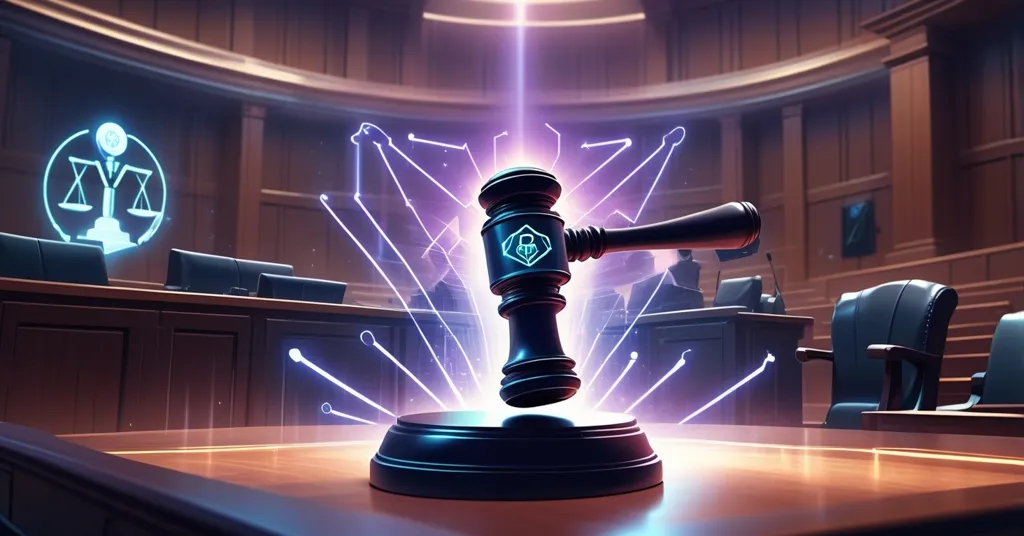Ripple’s SEC Win: XRP Price Surge and 2024 Outlook Amid Legal Victory

XRP SEC Victory: Ripple’s Turning Point or Market Hype for 2024?
A historic legal battle came to a close on August 7 when the U.S. Securities and Exchange Commission (SEC) formally dropped its nearly five-year pursuit against Ripple, the blockchain company behind XRP. This resolution sparked an immediate 8% surge in XRP’s price, igniting speculation about whether this could trigger one of the biggest rallies in crypto history. But is this truly a game-changer for Ripple and the broader digital asset space, or just another fleeting headline in a volatile market?
- Legal Closure: SEC dismisses further action against Ripple, ending a prolonged dispute.
- Price Spike: XRP climbs 8% on the news, with wild predictions of $5 or $10 on the horizon.
- Regulatory Winds: Pro-crypto policies and potential ETF approvals could fuel further growth.
Legal Victory Unpacked: A Milestone for Ripple
The Ripple-SEC saga, launched in December 2020, hinged on a critical debate: Is XRP a security under U.S. law? For those new to the concept, a security is a financial instrument like a stock or bond that must be registered with the SEC, requiring rigorous disclosures. Ripple argued XRP was a digital currency, not tied to the company’s performance like an investment contract. The SEC, however, claimed Ripple’s sales—especially to institutional buyers—violated securities laws by bypassing registration.
A breakthrough came in July 2023 when a federal judge delivered a nuanced ruling: XRP sales on public exchanges didn’t qualify as securities, but direct sales to big investors (think private deals with hedge funds) did break the rules, slapping Ripple with a $125 million penalty. The final dismissal of further action by the SEC this August clears a massive overhang, letting Ripple shift focus from courtroom drama to its core mission—using blockchain for lightning-fast cross-border payments. SEC Chair Paul Atkins framed this as a turning point, noting:
This development is an opportunity to shift our energy from the courtroom to the policy drafting table.
But let’s not overstate the win. This ruling sets a precedent for how tokens are classified, potentially easing pressure on other projects like Cardano or Solana facing similar SEC scrutiny. Yet, it also underscores that institutional sales remain a regulatory minefield. Compliance costs for crypto firms are still brutal, and this victory doesn’t mean the SEC is suddenly crypto’s best friend. Could this embolden regulators to double down on other targets? It’s a question worth chewing on.
Market Reaction: Pump or Sustained Rally?
XRP’s price jumped 8% almost instantly after the news broke, reflecting a burst of relief among traders. Some technical analysts are hyping up chart patterns—think shapes on a price graph that supposedly predict upward moves—claiming XRP could rocket 55% to $5, or even hit $10, a jaw-dropping 215% gain from its current level around $3.20. I’m not here to peddle fairy tales, though. Most of these XRP price predictions for 2024 are little more than educated guesses, often rooted in past trends or pure hope rather than cold, hard data. I’ve waded through enough crypto hype to know that crystal ball nonsense rarely pans out.
The reality? Much of this legal outcome was already baked into XRP’s price. Savvy investors have tracked every twist of this case for years, so the 8% bump feels more like a knee-jerk reaction than the start of a moon mission. Plus, XRP’s fate is still tethered to Bitcoin’s broader market moves. If BTC stumbles—and it often does during global economic hiccups—don’t expect XRP to float above the wreckage. So, while the short-term sentiment is bullish, sustained gains are far from a sure bet. Are we looking at a real breakout or just another pump-and-dump cycle?
Future Catalysts: ETFs and Policy Shifts
What could genuinely push XRP higher? A few big catalysts are floating on the horizon. First up is the rumor of a spot XRP Exchange-Traded Fund (ETF), with a supposed decision deadline of October 17. For the uninitiated, an ETF is a product traded on stock exchanges that tracks an asset’s price—here, XRP—allowing investors to buy in through regular brokerage accounts without needing a crypto wallet. Think of it as a bridge between traditional finance and digital assets. If approved, an XRP ETF could draw floods of retail and institutional money, much like Bitcoin and Ethereum ETFs did in recent months. But let’s not get ahead of ourselves. The SEC has a history of dragging its feet or outright rejecting crypto ETFs over concerns like market manipulation. There’s no ironclad confirmation of this date, and regulatory snags could easily derail the hype train.
Then there’s the political angle. Under the Trump administration, pro-crypto policies are gaining traction, including talk of an executive order to expose digital assets to the $9 trillion 401(k) market. For context, 401(k) plans are U.S. employer-sponsored retirement accounts, and they’ve historically been walled off from alternative assets like crypto due to legal and fiduciary risks. A White House document explicitly mentions enabling “holdings in actively managed investment vehicles that are investing in digital assets,” which could funnel unprecedented capital into XRP and its peers. Add to that legislative efforts like the CLARITY ACT, aimed at defining how digital assets fit into financial frameworks, and you’ve got a potential recipe for mainstream adoption. Still, government gears turn slower than a Bitcoin transaction on a clogged network. Don’t bank on instant results.
Economic tailwinds also play a role. Softer-than-expected inflation data has markets anticipating up to three Federal Reserve interest rate cuts before year-end. Lower rates often make risk assets like cryptocurrencies more appealing as investors chase returns outside sleepy bonds or savings accounts. Historically, dovish monetary policy has sparked inflows into speculative markets, including crypto. But here’s the catch—global recession fears or equity market slumps could just as easily sour the mood. Crypto’s growing correlation with traditional stocks means XRP isn’t immune to macro meltdowns. It’s a high-wire act, and the safety net looks thin.
Risks and Roadblocks: The Other Side of the Coin
Despite the legal win, XRP isn’t out of the woods. Market volatility remains the name of the game—today’s 8% pump could be tomorrow’s 15% crash, especially if Bitcoin takes a nosedive. Regulatory uncertainty hasn’t vanished either. Even if an ETF gets the green light, the fine print of crypto regulation in the USA could still trip up adoption. The SEC might pivot from Ripple to other projects, casting a shadow over the industry’s growth. And let’s not forget macro headwinds. If economic conditions sour—think recession or geopolitical shocks—risk assets like XRP often get dumped faster than a bad meme coin.
XRP-specific challenges loom large too. Ripple’s tech faces competition from other payment-focused blockchains like Stellar, which also aim to revolutionize cross-border transfers with speed and low costs. More controversially, Ripple’s centralized aspects—such as control over key validators in its network—rub decentralization purists the wrong way. As someone with a Bitcoin maximalist streak, I’ll admit XRP serves a niche BTC doesn’t, with its focus on efficient transactions over being a pure store of value. But centralization risks clash with the ethos of freedom and privacy we champion. Can XRP truly align with the decentralized revolution, or will it remain a hybrid oddity? If you’re curious about broader opinions on this, community discussions on platforms like Reddit highlight mixed views on the impact of Ripple’s legal win.
Broader Crypto Context: Speculation and Precedents
Zooming out, the wider altcoin market is in full speculative fever. Low-cap meme coins like TROLL have doubled in value in a week, fueled by little more than Twitter buzz and FOMO. This gambling vibe could spill over to XRP, boosting short-term gains, but it also screams bubble territory—prone to savage corrections. Amid this frenzy, new projects like Snorter ($SNORT), a trading bot with presale buzz, have popped up, raising over $2.5 million in presale. With features like jumping the queue on token launches and supposed scam protection, it’s tempting for retail punters. But staking yields touted as high as 266%? That smells like a promise from a crypto bedtime story. Most presale schemes are closer to roulette than retirement plans. If you’re eyeing such bets, tread with extreme caution—scammers thrive in this space.
Ripple’s win also sets a legal benchmark. Compared to ongoing SEC battles with giants like Coinbase or Binance, this outcome suggests challenging regulatory overreach can pay off. It might inspire other firms to fight rather than fold, potentially speeding up clarity for digital assets. But the flip side is grim—if the SEC recalibrates to hit harder elsewhere, innovation could take a backseat to legal wrangling. The crypto space is still a wild west, and Ripple’s victory is just one skirmish in a much larger war. For a deeper dive into the implications, check out this analysis of Ripple’s legal outcome.
What’s Next for XRP and Crypto?
Looking ahead, XRP stands at a crossroads. The legal cloud has lifted, and catalysts like ETF approvals or 401(k) integration could carve out a bigger role for it in the financial landscape. Its knack for fast, cheap transactions fills a gap Bitcoin doesn’t prioritize, positioning it as a practical tool in the push for decentralized systems. Yet, the path is riddled with potholes—volatility, competition, and lingering regulatory fog could sap momentum. For the broader crypto revolution, Ripple’s case hints at a slow thaw in regulatory hostility, but the battle for true freedom from centralized control is far from won. For more background on the company and its journey, Ripple Labs’ history provides useful context.
As champions of effective accelerationism, we see every step toward mainstream adoption—flawed or not—as progress worth dissecting. XRP might not be the pure embodiment of decentralization we idolize in Bitcoin, but it’s a piece of the puzzle in disrupting the status quo. The question remains: can it balance utility with the risks of hype and overreach? Keep your skepticism sharp and your portfolio diversified. This ride’s only getting started. If you’re wondering about the specifics of the lawsuit’s resolution, details are well-documented in this report on the SEC’s waiver and its impact.
Key Takeaways and Questions for Crypto Enthusiasts
- What does Ripple’s SEC victory mean for XRP’s future?
It clears a major legal hurdle, driving an 8% price spike and boosting confidence, potentially paving the way for wider adoption if regulatory and market conditions align. - How could pro-crypto policies under the Trump administration impact XRP?
Opening the $9 trillion 401(k) market to digital assets could unleash massive capital inflows, though legal and fiduciary barriers might delay or limit the effect. - Can XRP hit $5 or $10 as some predict for 2024?
While ETF approvals and rate cuts could spur gains, these targets are speculative, hinging on Bitcoin’s performance and broader market sentiment rather than guarantees. - What risks still threaten XRP despite this legal win?
Volatility, regulatory uncertainties around ETFs, macro-economic downturns, and competition from other blockchains could derail sustained growth. - How does Ripple’s win affect other altcoins and the crypto industry?
It sets a precedent that may encourage other projects to challenge SEC actions, but it also signals ongoing regulatory focus on institutional sales, keeping compliance pressures high. - Should investors dive into speculative projects like Snorter ($SNORT)?
Proceed with extreme caution—high yields and presale hype often mask scams or unsustainable models, demanding rigorous due diligence.


